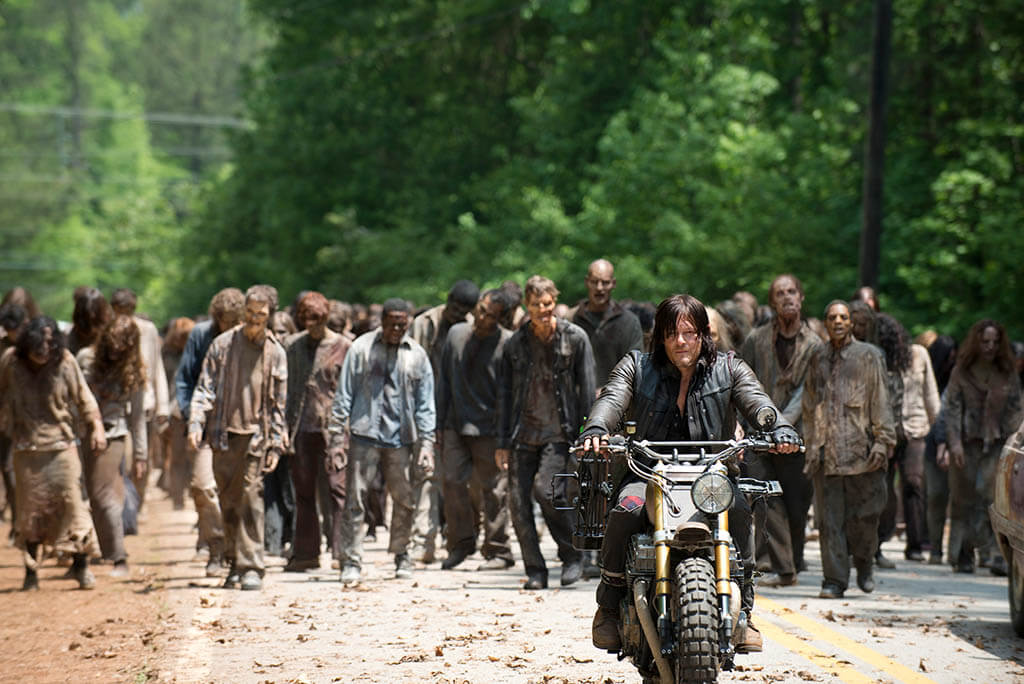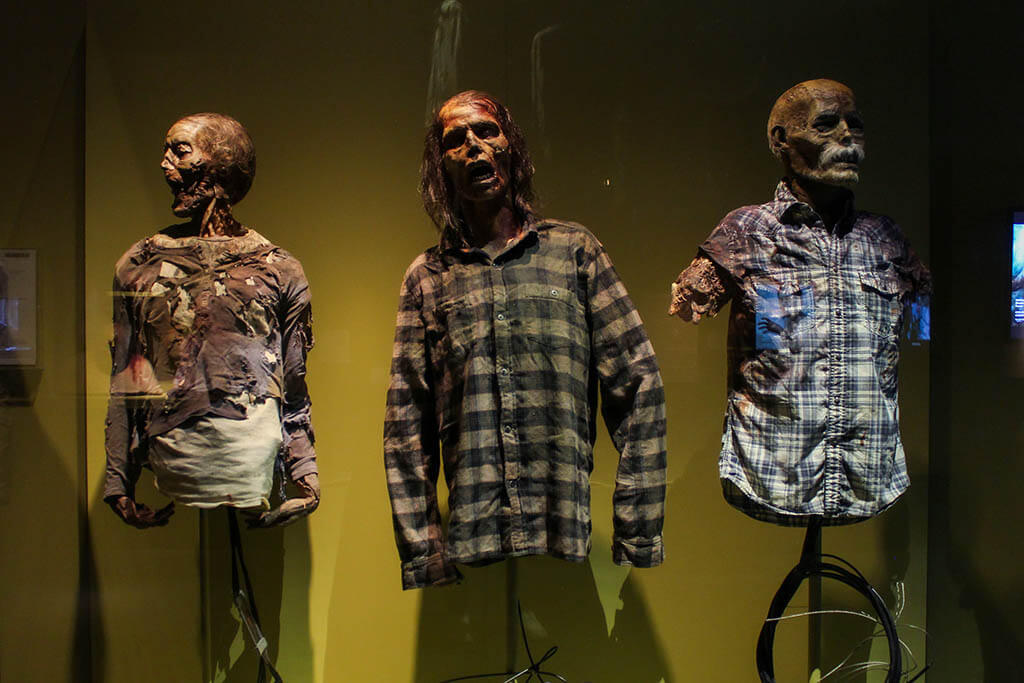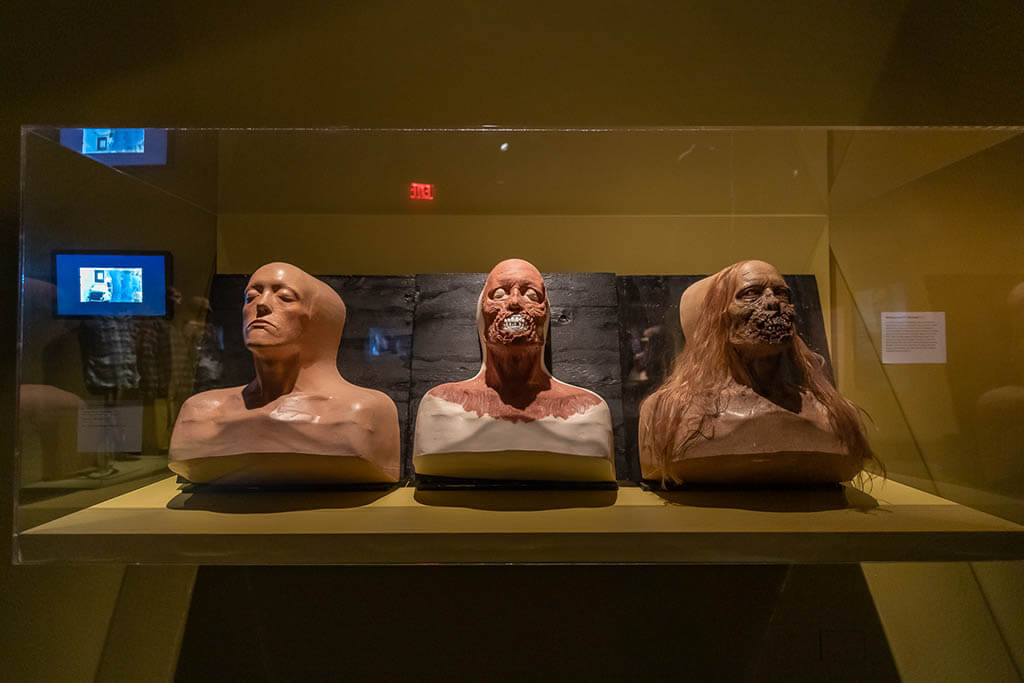By TREVOR HOGG
By TREVOR HOGG

The Walking Dead has played a major role in reviving the use of prosthetic makeup in television productions. (Image courtesy of AMC)
Getting up close and personal with zombies is never recommended unless you want to visit the Museum of the Moving Image’s exhibition Living With The Walking Dead, which can be viewed in Astoria, Queens, New York until January 22, 2023. In the section of the exhibition called ‘Making Up the Dead,’ the contributions of KNB EFX and Greg Nicotero, who serves as the Special Effects Makeup Supervisor, Executive Producer and Director for the series, are on display, in particular, busts for T-Dog (IronE Singleton) and Noah (Tyler James Williams), Negan Smith’s (Jeffrey Dean Morgan) baseball bat ‘Lucille,’ a life mask of Steven Yeun and an animatronic head for character Hershel Greene (Scott Wilson).

The television format has allowed for the exploration of zombies at different stages of decomposition and exposed to various types of environmental conditions. (Image courtesy of AMC)
“I came up with a bunch of ways to create silkscreen zombie masks that were designs that we did, printed them on silk, cut them out and made pullover masks. Then we would put wigs on them and put them way in the background. All of a sudden, we were able to populate a scene with a hundred zombies by using 60 or 70 of these background silk masks, and then the hero makeup would be up front. Even things as simple as that did a tremendous amount to allow us to fine-tune the process…”
—Greg Nicotero, Special Effects Makeup Supervisor/Executive Producer/Director

Michonne (Danai Gurira) fends off zombies in a shot taken from the AMC production of The Walking Dead. (Image courtesy of AMC)
“I have been doing this for a long time,” Nicotero states. “Even in my house, I have two rooms filled with memorabilia and props that I have saved or collected from movies. I have one of the ears from Reservoir Dogs and the crate from Creepshow. I have a lot of cool stuff that I have held onto because they have sentimental value to me.”

Greg Nicotero with one of his zombie creations. (Image courtesy of AMC)
Considering The Walking Dead deals with a virus that causes a pandemic, having to live through the global mayhem caused by COVID-19 was a surreal experience for Nicotero. “We spent years talking about how people would react and what would they do,” he recalls. “And when we found ourselves in the middle of toilet paper shortages, we all went, ‘Huh, never thought about that.’” The process had to be modified because of on-set protocols. Explains Nicotero, “The pandemic did alter certain ways of how we look at prosthetic makeup because there was a big concern about having people too close to each other for long periods of time. Also, putting contact lenses into performers was something they were not interested in doing. We worked quickly on our feet. I came up with a bunch of ways to create silkscreen zombie masks that were designs that we did, printed them on silk, cut them out and made pullover masks. Then we would put wigs on them and put them way in the background. All of a sudden, we were able to populate a scene with a hundred zombies by using 60 or 70 of these background silk masks, and then the hero makeup would be up front. Even things as simple as that did a tremendous amount to allow us to fine-tune the process, and get the makeup time down to a hour and 15 minutes versus two and a half hours.”

Nicotero serves as an Executive Producer, Special Effects Makeup Supervisor and Director on The Walking Dead. (Image courtesy of AMC)

Nine mannequins costumed as key characters in the show, including Rick, Morgan, Negan, Carol, Daryl, Maggie, Michonne, Father Gabriel and Jadis. (Photo: Thanassi Karageorgiou/Museum of the Moving Image)
“[W]hen we first premiered, I feel like it had a big hand in reintroducing prosthetic makeup to this generation of viewers. When I got into the industry in the late 1970s early 1980s, that’s what it was all about. It was Tom Savini, Rick Baker, Rob Bottin and Stan Winston, and you had The Thing, American Werewolf in London, Dawn of the Dead and The Howling, which were low budget and didn’t have big casts. The special effects were the star.”
—Greg Nicotero, Special Effects Makeup Supervisor/Executive Producer/Director
When pitching the original series, Executive Producers Frank Darabont and Gale Anne Hurd took four zombie busts made by Nicotero’s company KNB EFX to their meetings. “Frank and Gale did that because the big question mark over everybody’s heads was, ‘How are we going to do this?’” Nicotero recalls. “In Season 1, we put everything into doing as much practically as possible, including the blood rigs. We made little rigs that would clip onto the backs of the actors, that went to a tube with a bellow, and you would stomp on the bellows and the blood would spray out. There were a lot of practical head hits in the first season.” The process was changed for subsequent seasons. “We had to adapt a lot of what we do to be able to move fast. Plus, if you do a gag where there is a lot of blood everywhere, the amount of time it takes to clean up and do take two is not necessarily beneficial on a television schedule. A lot of the head hits and bullet entry and exit wounds ended up being done digitally because it was more production friendly and allowed more flexibility in the shoot because we didn’t have to cut and hide anything.”

Entrance and title wall of the Living With The Walking Dead exhibition at Museum of the Moving Image, located in Astoria, New York. (Photo: Thanassi Karageorgiou/Museum of the Moving Image)
Old practical techniques were revived. “One of the things that I’m grateful for with The Walking Dead is when we first premiered, I feel like it had a big hand in reintroducing prosthetic makeup to this generation of viewers,” Nicotero notes. “When I got into the industry in the late 1970s early 1980s, that’s what it was all about. It was Tom Savini, Rick Baker, Rob Bottin and Stan Winston, and you had The Thing, American Werewolf in London, Dawn of the Dead and The Howling, which were low budget and didn’t have big casts. The special effects were the star. I do believe that The Walking Dead, with the advent of digital effects and CGI, stopped everybody and said, ‘Wait minute. This art form is not only long forgotten but is still tremendously relevant and can play a big part in the production of a TV show.’ The Walking Dead celebrated that art form in way that people haven’t done in a long time because most people do it digitally or will fix it later. I thought the exhibit was a great opportunity not only to showcase the props but the steps that are taken to get from A to Z.”

Shown are various masks for Whisperers (left), the costume and mask worn by Samantha Morton as Alpha (center), and animatronic heads for Henry, Tara and Enid (right). (Photo: Thanassi Karageorgiou/Museum of the Moving Image)
“The Walking Dead celebrated that art form in way that people haven’t done in a long time because most people do it digitally or will fix it later. I thought the exhibit was a great opportunity not only to showcase the props but the steps that are taken to get from A to Z.”
—Greg Nicotero, Special Effects Makeup Supervisor/Executive Producer/Director
Combining digital and practical elements led to the best results, with one case being the Hershel animatronic head. “That’s how you fool the audience; you use the best tools in your arsenal,” Nicotero remarks. “We did a life cast of Scott Wilson and made an animatronic head that had four-way jaw movement so that the head can move around a little bit. We ended up digitally augmenting the eyes. We shot somebody wearing zombie contact lenses, and then composited real eyes over the puppet head because that’s probably the most challenging aspect of doing any type of animatronic, getting the eyes to have life in them. Ironically, when we shot that scene, a fly landed on the animatronic head during the take, and we had it so that the eyes looked at the fly when it landed. It was a simple execution, but was something that forever remains etched in The Walking Dead chronicles.”

Living With The Walking Dead exhibition at the Museum of the Moving Image features original costumes, props, scripts and special effects makeup. (Photo: Thanassi Karageorgiou/Museum of the Moving Image)

The makeup process for ‘bicycle girl’ is on display as part of Museum of the Moving Image’s Living With The Walking Dead exhibition. (Photo: Thanassi Karageorgiou/Museum of the Moving Image)
The execution of Glenn Rhee (Steven Yeun) had to convey the proper gravitas for the character. “We used the horrific elements of the comic book as a guide, which to me was the senseless murder of Glenn,” Nicotero reflects. “It happened so quickly and abruptly in the comic book that we didn’t have time to process what exactly had happened. That to me was the shocking element. When we got to the TV show, we had shot 83 episodes, so the difficulty was that people loved that character. There were a lot of us who didn’t want to see Glenn go because the character provided a grounded heart to the show, which I still believe to this day. I would have done it differently, but that was the script. Those were all practical elements. We had various stages of makeup on Steven, then we had a puppet head, and dummy bodies for impact. It was all to service the introduction of this absolutely despicable character. There weren’t a lot of visual effects involved in that.”
“We did a life cast of Scott Wilson and made an animatronic head that had four-way jaw movement so that the head can move around a little bit. We ended up digitally augmenting the eyes. We shot somebody wearing zombie contact lenses, and then composited real eyes over the puppet head because that’s probably the most challenging aspect of doing any type of animatronic, getting the eyes to have life in them. Ironically, when we shot that scene, a fly landed on the animatronic head during the take, and we had it so that the eyes looked at the fly when it landed. It was a simple execution, but was something that forever remains etched in The Walking Dead chronicles.”
—Greg Nicotero, Special Effects Makeup Supervisor/Executive Producer/Director

A close-up of an animatronic Scott Walker (Hershel Greene). (Photo: Thanassi Karageorgiou/Museum of the Moving Image)

A close-up of an action figure of Hershel Greene. (Photo: Thanassi Karageorgiou/Museum of the Moving Image)
Nicotero has also collaborated with the founder of the zombie genre, George Romero. “Up until The Night of the Living Dead, zombies were considered voodoo lore. It was never a creature that was a reanimated corpse that feasted on the flesh of the living. I 100% believe that the reintroduction of the zombie genre into society is solely based on two items. As soon as you add a plastic gun and create a first-person-shooter video game where you’re responsible for shooting zombies and saving yourself, that opened the zombie genre to an entirely new generation of people playing House of the Dead and Resident Evil. Then we had 28 Days Later, Shaun of the Dead, Resident Evil [the movie] and the Dawn of the Dead remake. The advantage that you have in a television series, where there had never been one before this, was that you have the ability to say, ‘This person just died, so they’re freshly dead, but now there’s a corpse over here that has been lying in the sun for six weeks, so it looks like a pumpkin two months after Halloween.’ A zombie trapped inside of a building isn’t exposed to the sun, so it would be better preserved than ones that have been outside. We would take into consideration weapons and how the zombie died. Eighty percent of the time it was up to us in the makeup trailer to concoct these backstories, and then we would tell the story in the prosthetic makeup.”